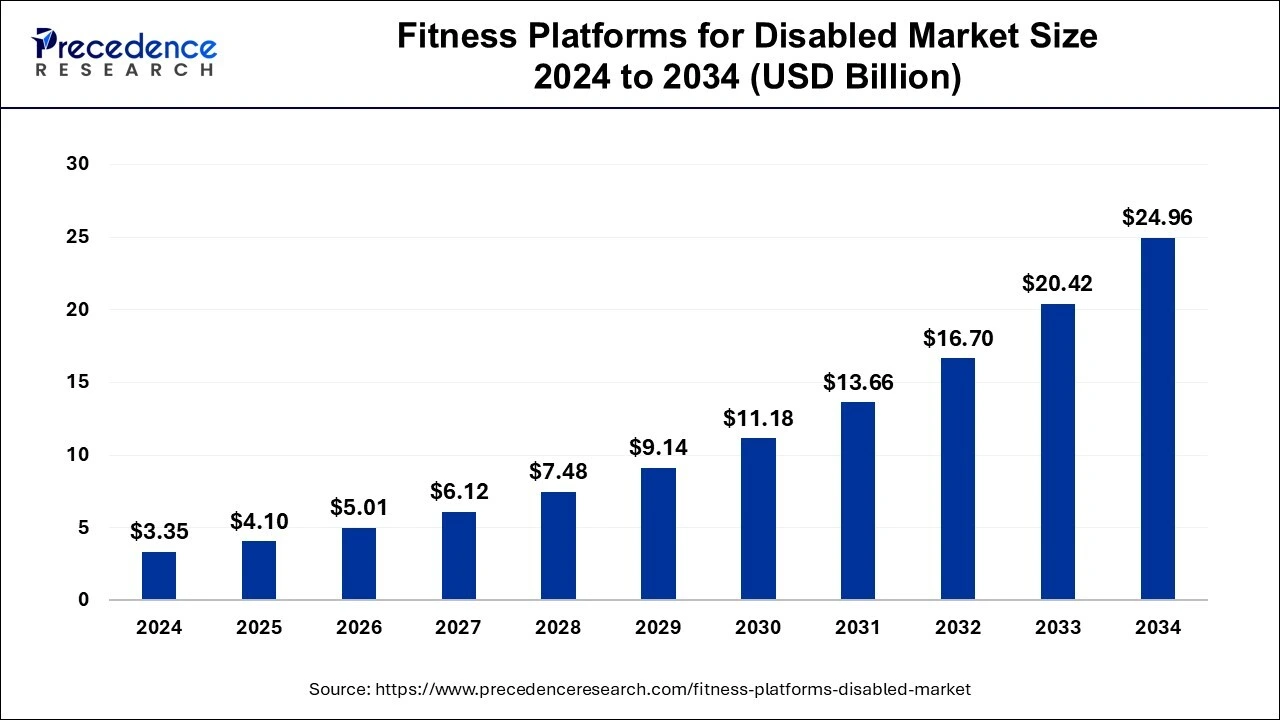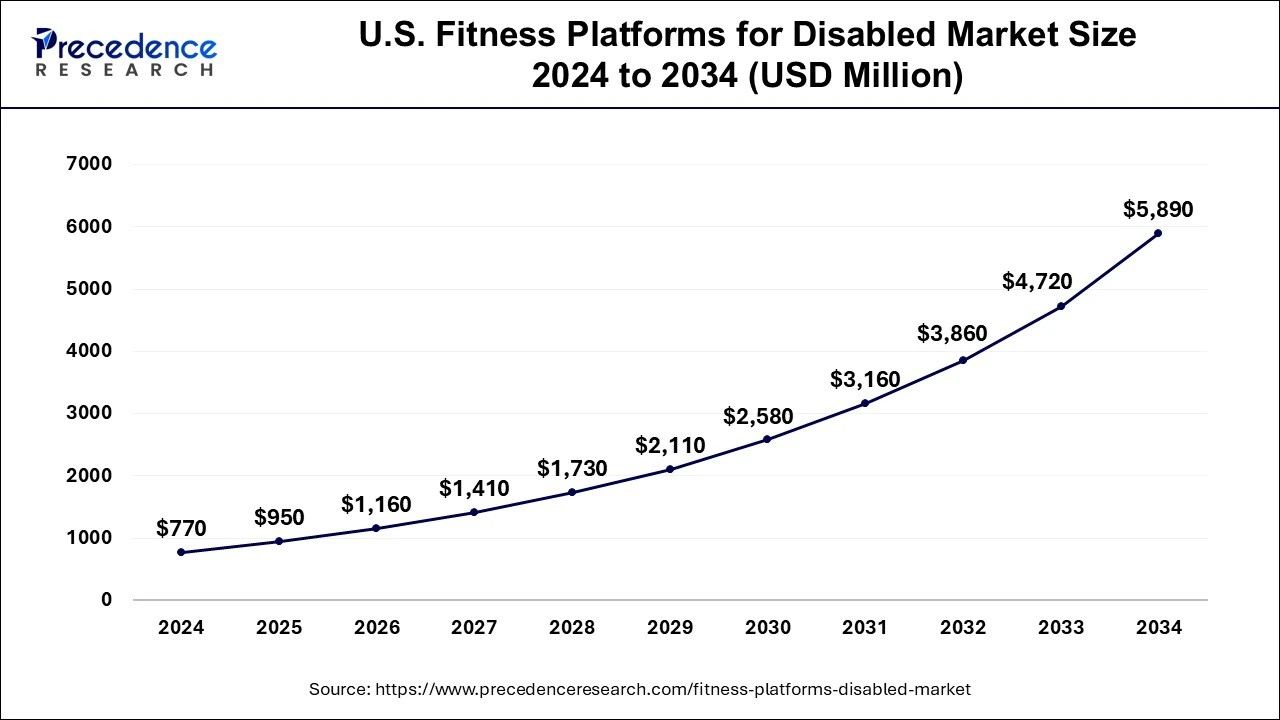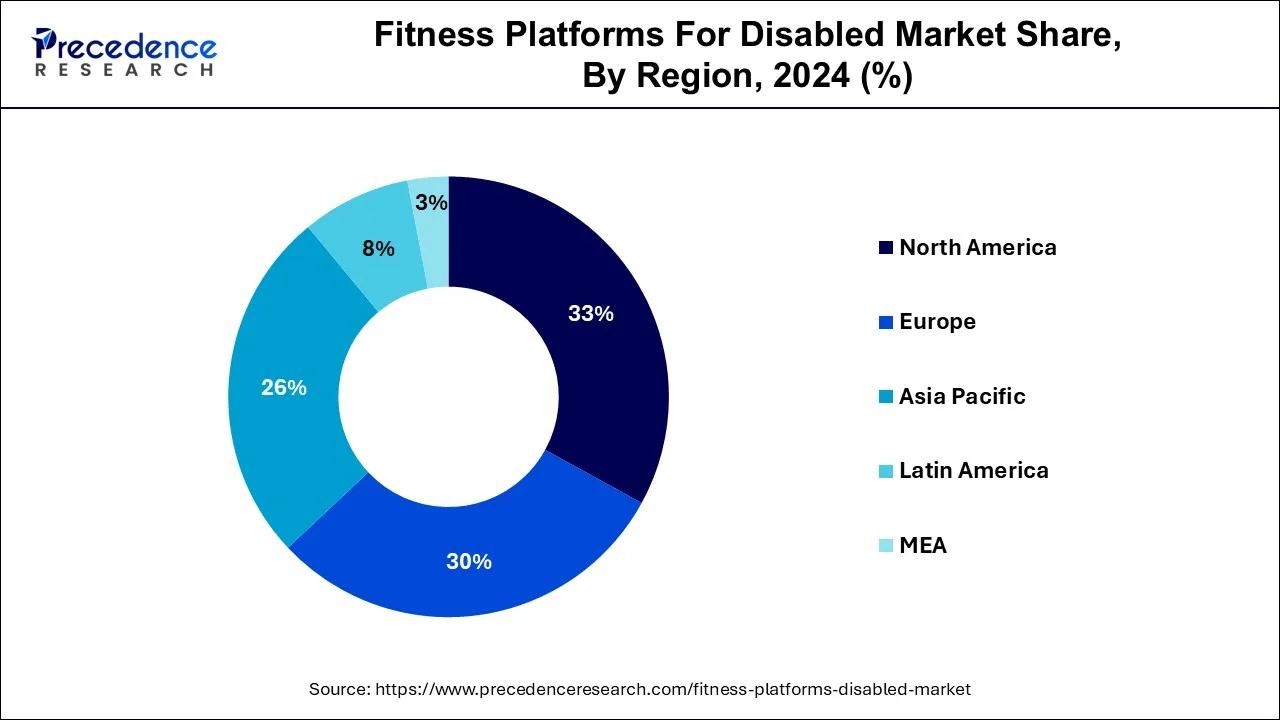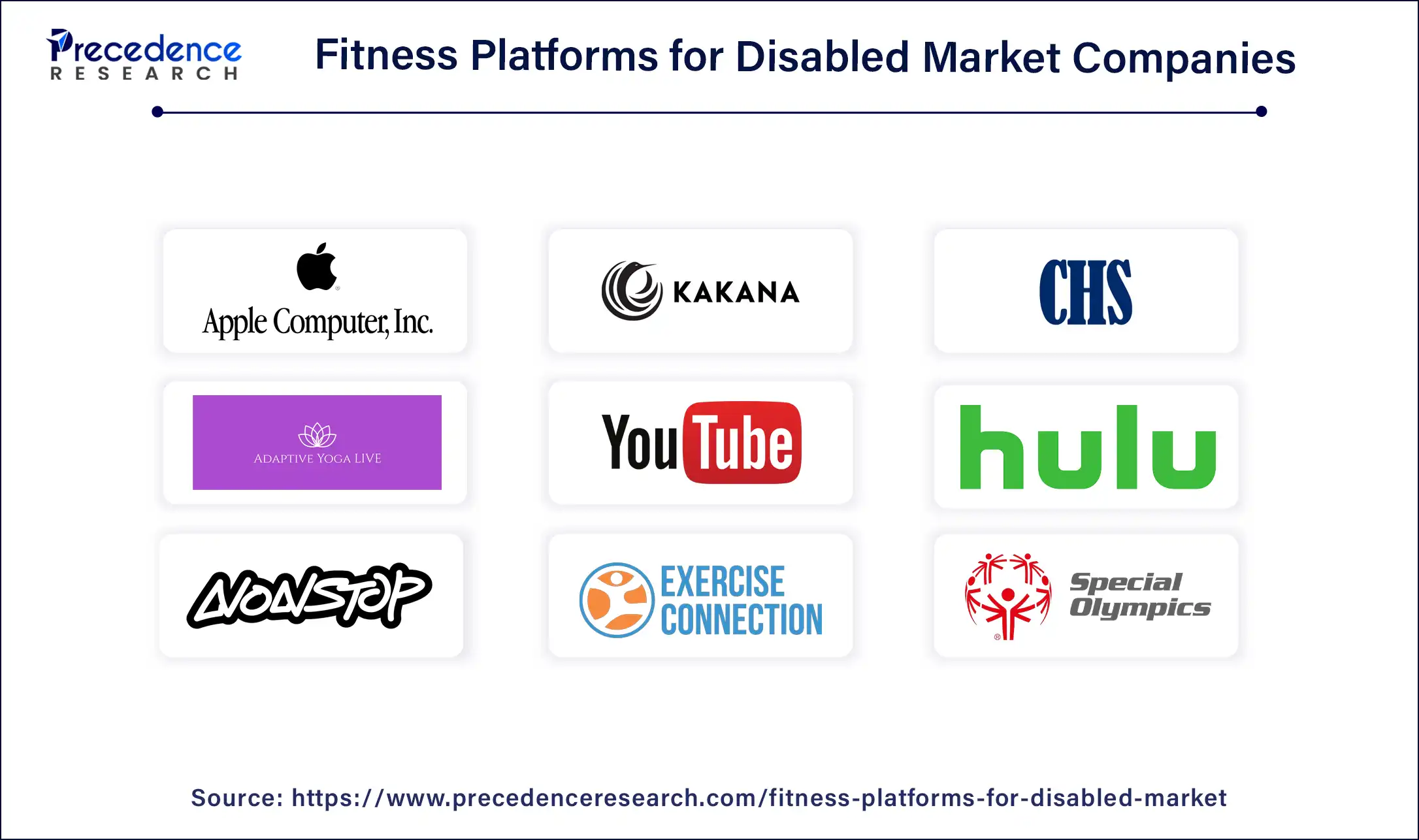July 2023
The global fitness platforms for disabled market size is calculated at USD 4.10 billion in 2025 and is forecasted to reach around USD 24.96 billion by 2034, accelerating at a CAGR of 22.24% from 2025 to 2034. The North America market size surpassed USD 1.11 billion in 2024 and is expanding at a CAGR of 22.37% during the forecast period. The market sizing and forecasts are revenue-based (USD Million/Billion), with 2024 as the base year.
The global fitness platforms for disabled market size was calculated at USD 3.35 billion in 2024 and is predicted to reach around USD 24.96 billion by 2034, expanding at a CAGR of 22.24% from 2025 to 2034. The fitness platforms for disabled market are driven by the rising awareness of the importance of physical activity and fitness for individuals with disabilities.

Artificial Intelligence can build personalized exercise programs for impaired individuals by analyzing their objectives, abilities, and health data. AI algorithms adapt the type, duration, and intensity of exercises to the user's needs, whether related to mobility, visual or auditory, or cognitive issues. AI assists fitness platforms in producing adaptable content, including exercise adjustments for various disabilities, films with sign language interpretation, and descriptive audio for the visually impaired. Platforms may ensure that content is available to everyone by examining user preferences and requirements. Wearables, cameras, or sensors with AI capabilities can tailor movement patterns and offer thorough feedback on form, posture, and advancement. These technologies can guarantee that individuals with restricted strength or mobility do workouts correctly and lower their risk of harm.
The U.S. fitness platforms for disabled market size was evaluated at USD 770 million in 2024 and is projected to be worth around USD 5,890 million by 2034, growing at a CAGR of 22.56% from 2025 to 2034.

North America dominated fitness platforms for disabled market in 2024. To improve accessibility, fitness systems are using adaptive technologies like eye tracking, haptic feedback, and voice instructions more and more. These developments make exercise activities more accessible to people with various physical limitations. There is a rising market for platforms specifically created for persons with disabilities as they seek more inclusive services. Younger demographics and the aging population, many elderly adults suffering from mobility-related disabilities, are driving this demand and expanding the customer base.
According to the U.S. Centers for Disease Control and Prevention, the data states the following:

Asia-Pacific is observed to be the fastest growing fitness platforms for disabled market during the forecast period. Asia-Pacific has seen a steady rise in investment in the health-tech industry, with government subsidies and venture capital firms assisting entrepreneurs who prioritize accessibility. Funding for fitness platforms that serve people with impairments has increased dramatically, creating an environment conducive to creative solutions. Its fitness and wellness culture is expanding, as seen by the rise in wellness-focused goods and services in nations like China and India. Recognizing fitness for individuals of various capacities is one aspect of this change that fuels interest in platforms that facilitate adaptive exercise.
In order to improve inclusivity in the fitness sector and make it easier for people with disabilities to participate in physical activity, accessible fitness platforms accommodate a range of physical abilities. Fitness may become more accessible than ever due to developments in wearable technology, artificial intelligence, and adaptable exercise gear. Platforms that include these technologies can offer data tracking, accessible information, and real-time feedback to customize exercises to each person's unique requirements. Users gain empowerment, track their progress, and maintain motivation.
| Report Coverage | Details |
| Market Size by 2024 | USD 3.35 Billion |
| Market Size in 2025 | USD 4.10 Billion |
| Market Size in 2034 | USD 24.96 Billion |
| Market Growth Rate from 2025 to 2034 | CAGR of 22.24% |
| Dominating Region | North America |
| Fastest Growing Region | Asia Pacific |
| Base Year | 2024 |
| Forecast Period | 2025 to 2034 |
| Segments Covered | Type, Platform, Devices, and Regions |
| Regions Covered | North America, Europe, Asia-Pacific, Latin America, and Middle East & Africa |
Investors are increasingly recognizing the potential of disability
In recent years, the fitness industry has seen a discernible cultural shift in favor of diversity. The inaccessibility of traditional fitness models is being questioned, and companies are under increasing pressure to serve various consumers, including people with cognitive, physical, or sensory impairments. In addition to addressing a need in the market, businesses that develop fitness programs that cater to these requirements are also supporting the more significant social movement for equality and inclusivity.
According to investors, platforms that cater to the particular fitness requirements of people with disabilities are in high demand. These include customized training plans, specialized equipment, virtual coaching services, and adaptive workout routines.
Lack of specialized workout programs and fitness content
Fitness instructors who are educated to handle a variety of physical restrictions and knowledgeable about adapting workouts may be necessary for disabled people. Such specialized trainers are unavailable on most fitness platforms, and the adaptive fitness industry lacks certified experts. There are still few adaptive fitness specialized trainers, and those present might not always be readily available online. There is a void in the kind of individualized direction required for safe and successful training when these trainers are not present.
Advances in technology
Through voice-activated capabilities, fitness apps can be used by people with limited movement, doing away with the need for physical contact. AI assistants can offer encouragement, feedback, and fitness guidance. Healthcare providers can monitor wearables in real-time by integrating them with fitness platforms. This opens the door to more individualized exercise regimens that address the medical requirements of people with disabilities. AI can make fitness more accessible and attainable by offering feedback during workouts and suggesting adjustments depending on a user's real-time performance. For instance, depending on the user's performance or physiological reactions, the system may alter the exercises or lower the intensity.
The exercise & weight loss segment dominated the fitness platforms for disabled market in 2024. The value of exercise and weight control in enhancing the general health of those with disabilities is becoming more well-recognized. The benefits of regular exercise in reducing secondary health problems, including obesity, diabetes, and cardiovascular disease, have been repeatedly demonstrated by research, raising demand for readily available fitness platforms. Real-time feedback is offered by wearables and sensors designed for people with physical disabilities, enabling users and trainers to modify workouts as necessary. These gadgets make exercise and weight loss more attainable by precisely monitoring progress and establishing realistic targets.
The activity tracking segment is observed to be the fastest growing in the fitness platforms for disabled market during the forecast period. As awareness around diversity in health and fitness rises, firms are increasingly introducing fitness platforms with accessibility features that allow impaired users to track their activities successfully. To make these platforms user-friendly for those with a range of disabilities, they provide features including voice help, haptic feedback, font size adjustments, and simple navigation. The adoption rates of these platforms are rising due to this drive for diversity.
The iOS segment dominated the fitness platforms for disabled market in 2024. When it comes to technology accessibility, Apple has long been at the forefront. The company makes it simpler for developers to create apps for people with disabilities by integrating several accessibility features into iOS. These features, which improve usability for those with various disabilities, include VoiceOver, AssistiveTouch, Switch Control, and real-time captioning. To keep accessibility features and fitness data current, safe, and dependable for customers, Apple also strongly emphasizes frequent updates and security fixes. More people choose to remain in the Apple ecosystem because they believe the company is constantly investing in accessibility and will continue to meet their demands as technology advances.
The android segment shows a significant growth in the fitness platforms for disabled market during the forecast period. Fitness platforms can provide customized accessibility features for individuals with specific disabilities because of Android's wide range of customization capabilities. Fitness applications, for example, can modify text size, color contrast, or auditory feedback to improve usability for users who are blind or hard of hearing. Because Android is open-source, developers can make custom apps for people with disabilities. Numerous developers are creating fitness applications with features tailored to the needs of people with disabilities, like personalized workout plans or in-app instructions that accommodate users with limited movement.
The smartphones segment dominated the fitness platforms for disabled market in 2024. Numerous health and exercise applications tailored for individuals with disabilities are available on smartphones. These apps offer virtual classes, real-time coaching, and guided workout programs that address various needs related to neurodiverse diseases, eyesight impairments, and mobility constraints. Smartphones with wearable technology offer disabled people detailed information about their fitness progress, facilitating goal setting and progress monitoring. With the aid of this real-time feedback loop, users can make data-driven decisions regarding their fitness and health.
The wearable devices segment shows a significant growth in the fitness platforms for disabled market during the forecast period. Over time, wearable technology has expanded to incorporate capabilities that assist individuals with disabilities. Devices now come with features like haptic feedback, voice control, and assistive technology integration. For users with restricted mobility, these improvements enable more autonomous wearable interaction without the need for complicated handling or fine motor skills. Individualized exercise regimens are frequently required for people with impairments, and they can be difficult to oversee without ongoing input. By monitoring their health data and adjusting to their particular limits, wearable technology allows users to engage in personalized exercise regimens.

By Type
By Platform
By Devices
By Geography
For inquiries regarding discounts, bulk purchases, or customization requests, please contact us at sales@precedenceresearch.com
No cookie-cutter, only authentic analysis – take the 1st step to become a Precedence Research client
July 2023
January 2025
December 2023
August 2024